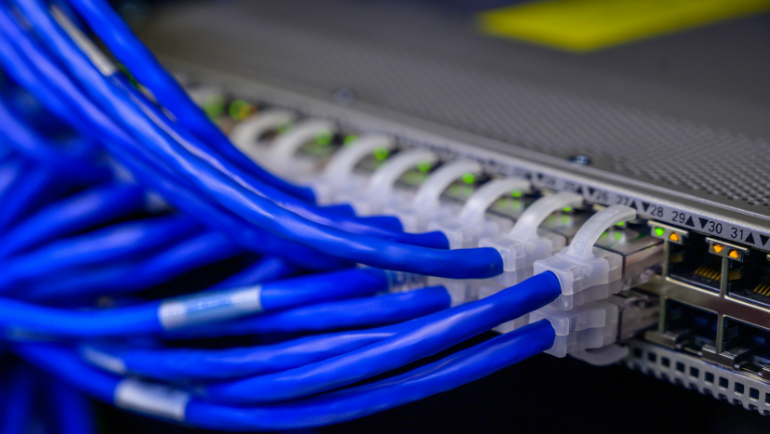
In the late 80s, businesses were looking for a way to visualize complex elements of networking systems using standard network language. The OSI (Open Systems Interconnection) Model is a standard network language developed by the ISO (International Organization for Standardization). It was created to fill the communication gap, providing a practical way to describe and analyze networks.
What is the OSI Model?
The OSI model is a conceptual framework for understanding and implementing computer networking. ISO created this concept of the OSI model to enable diverse communication using standard protocols between computers and other devices.
OSI model divides the communication system into seven layers each has a specific function and protocol. These layers are designed to facilitate interoperability between different systems ensuring effective communication over a network.
Layers Of OSI Model
The 7 layers of the OSI model are described as follows, from the highest to the lowest level.
Layer 7: Application layer
The application layer is the topmost layer of the OSI layer model. To initiate communication, it directly interacts with the user, software like web browsers, and email clients (Gmail, Outlook). Application layer protocols allow the software to direct data flow and present it to the user. Some of the known protocols include HTTP (HyperText Transfer Protocol), SMTP (Simple Mail Transfer Protocol), and FTP (File Transfer Protocol).
Layer 6: Presentation Layer
The presentation layer also known as the syntax or translation layer translates the application and makes it presentable for the application layer. Two networking devices can communicate using different syntaxes. Therefore, OSI model layers 6 translates the incoming data into a syntax that the application user can easily understand. This layer is also responsible for DES or AES encryption and the compression of data to reduce the number of bits used during data exchange.
Layer 5: Session layer
The session layer is responsible for initiating and closing the sessions among different wireless network devices like switches and routers.
It opens the session to transfer all the data and promptly closes to avoid wasting resources. For instance, if a user sends data of 1 GB, the session layer will keep a checkpoint after every 50 MB ensuring smooth data transmission. However, if the data transfer gets interrupted due to an internet crash, the session layer will restore it to the nearest checkpoint.
Layer 4: Transport Layer
The transport layer handles the end-to-end encryption between wireless devices also known as the heart of the OSI Layer model. Layer 4 takes data from the session layer breaks it into small chunks called segments and then forwards it to layer 3 (network layer). On the receiving end, the transport layer reassembles segments into data.
Layer 4 also performs two important functions: flow control and error control. Flow control ensures a perfect transfer speed for every device even with slow connection. Error control ensures there isn’t any error in any data segment and if there is, it can request the same data segment from the sender.
Layer 3: Network Layer
The network layer communicates between multiple networks. It receives data segments from the transport layer and further breaks down segments into smaller data packets. On the receiver end, this layer resembles the data into segments.
Layer 3 also identifies the shortest and most secure path for transmitting data packets using IP (Internet Protocol).
Layer 2: Data Link Layer
The data link layer transmits data between two nodes that are directly connected or working on the same network. This layer takes the data packets from layer 3 breaks into frames and forwards them to the receiver.
Layer 1: Physical layer
The layer caters to all the hardware equipment in the data transfer such as cables, switches, and wireless routers. It also converts the data into a string of bit 0s and 1s.
Applications of OSI Model
The OSI model layers offer a powerful framework with several real-world applications. Following are a few examples.
Troubleshooting
Networking issues are common among enterprises and the OSI model layers act as a roadmap for network troubleshooting. The layered structure makes it easy for IT professionals and experts to diagnose issues within the network. This model helps determine whether the problem lies with the web server (layer 7) or the internet connection (layer 3).
Network Design and Management
Network design and management allow the network designer to select the appropriate hardware and software for each level. The benefits of the OSI model enable smooth data flow, optimal network performance, and efficient resource allocation.
Security Analysis
OSI model layers help enterprises identify each layer’s potential security weaknesses. This benefit of the OSI model allows targeted security measures for each layer to avoid vulnerabilities and ensure network protection. Understanding the function of the OSI model and its layers is essential in detecting and mitigating attacks targeting specific network segments.
How Does the OSI Model Facilitate Data Communication?
To be in human understood format, all the information has to go through all seven layers of the OSI model. If you send an email and hit send on the application layer, it will choose a protocol for your email. Then it will pass through the presentation layer which will compress the data and hit the session layer initiating a communication session.
The data will then hit the sender’s transportation layer and convert into segments, then these segments will be broken up into packets at the network layer. After that, the data link layer breaks packets into frames and sends those frames to the physical layer, converting them into 1s and 0s and send via networking cables.
Alternative to the OSI model?
The TCP/IP (Transfer Control Protocol/Internet Protocol) is the most common alternative to the 7 layers of the OSI model.
| OSI Model | TCP/IP Model |
| Application Layer | Application Layer |
| Presentation Layer | |
| Session Layer | |
| Transport Layer | Transport Layer |
| Network Layer | Network Layer |
| Data Link Layer | Network Interface |
| Physical Layer |
The TCP/IP model seems a better option for networks extended across the public internet. It also accurately models the operation of Internet communication protocols. OSI is a general model and does not refer to specific protocols. Instead, the OSI reference model describes network communication as a whole.
TCP/IP is more focused on real-world networking implementation and interoperability, making it ideal for building and managing modern networks.
Popular Devices for OSI Models that you can buy
OSI model functions among networking devices and to ensure seamless connectivity between PCs and servers make sure you have operational devices. Computing worlds ensures getting the best switches that businesses can buy.
You can also request a bulk quote online for the top OSI model devices.
Frequently Asked Questions
Why did OSI fail?
OSI model attempted to standardize everything.
Is the OSI model obsolete?
No, the OSI model is relevant for its easy troubleshooting, flexible nature, and continued use as a teaching tool.
What OSI layer is HTTP?
The application layer includes protocols designed for end-users. For example, HTTP is a 7-layer OSI model.
The OSI model is not being used widely due to its successor TCP/IP offering a better and simpler version. However, to understand the network structure and its workings, focusing on the OSI model is the most effective way. The OSI model standardizes the networking system and assists in troubleshooting several networking problems. It enables MNCs (Multinational Corporations) to create products that can communicate and interact with software irrespective of physical makeup.
Stay tuned to the Computing Worlds blog for more tech information.






